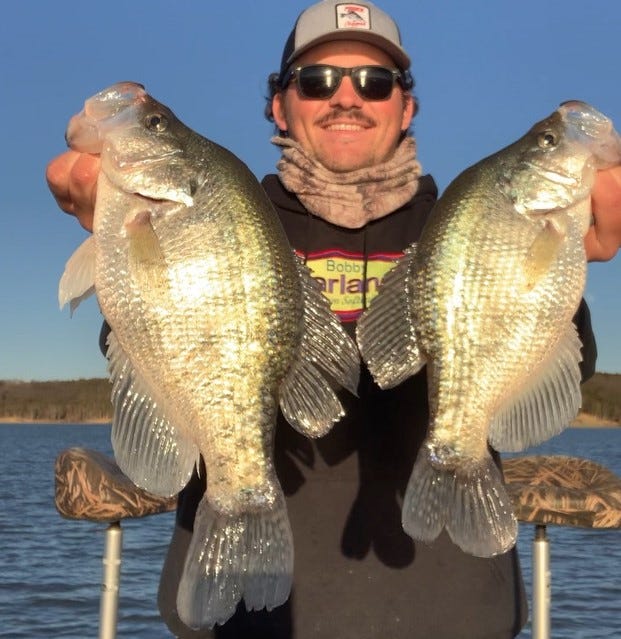- Feb 23, 2022
What Do I See? Your Guide to Interpreting Live Sonar
Learn how to make the best use of live sonar technology to improve your crappie fishing efficiency and catch more fish.
Early “Fish finders” were used primarily to find fish, as the term suggests, and to determine bottom depths and locate structure. Over time, technology has evolved, creating far clearer and more detailed pictures and many types of views and allowing anglers to determine bottom make-ups and find both structure and fish far more effectively
The latest electronics technology, live sonar, makes it far easier for anglers to recognize fish species, target specific fish and see how the fish react to lure presentations. It is highly popular for crappie fishing and extremely helpful if you know how make the best use of it.
Live sonar technology, which reveals high-resolution images of fish swimming and responding to lures, is available now via Garmin’s Panoptix LiveScope, Lowrance’s Active Target and Humminbird’s MEGA Live Imaging. For Dustin McDaniel, an Oklahoma tournament angler and guide (GFB Outdoors Guide Service, 417-437-5047), the ability to interpret what he is seeing on his Garmin 1222 unit with its Panoptix LiveScope transducer, has become a game-changer.
Live Sonar Lessons
McDaniel has discovered the advantages of live sonar over 2D sonar through extensive time spent scanning with LiveScope technology. He believes the biggest advantage of live sonar is the ability to accurately place his lure in front of a crappie and keep the lure in the fish’s strike zone. A fine-tuned 2D sonar also can achieve this task if the fish and lure are in the sonar’s sound wave cone near the boat, whereas the live sonar can display these images farther in front or to either side of the boat.
Live sonar’s ability to scan fish close to and farther away from the boat allows anglers to make accurate horizontal and vertical presentations to crappie, while traditional sonar works best for vertical presentations.
The high-resolution image generated by live sonar also helps McDaniel determine which way crappie are facing. The image is clear enough that McDaniel can determine the head and tail of a crappie, which allows him to constantly present his lure in front of the fish.
The Oklahoma guide noted that live sonar is changing anglers’ perceptions of crappie habits. “A lot of that stuff we are learning now we would have never known without live sonar,” McDaniel said. “There are a lot of old-timers who have fished for 20 or 30 years who are learning that a lot of their thoughts and stuff were myths, and that is due to live sonar teaching them a lot more than they ever knew.”
Identifying Crappie
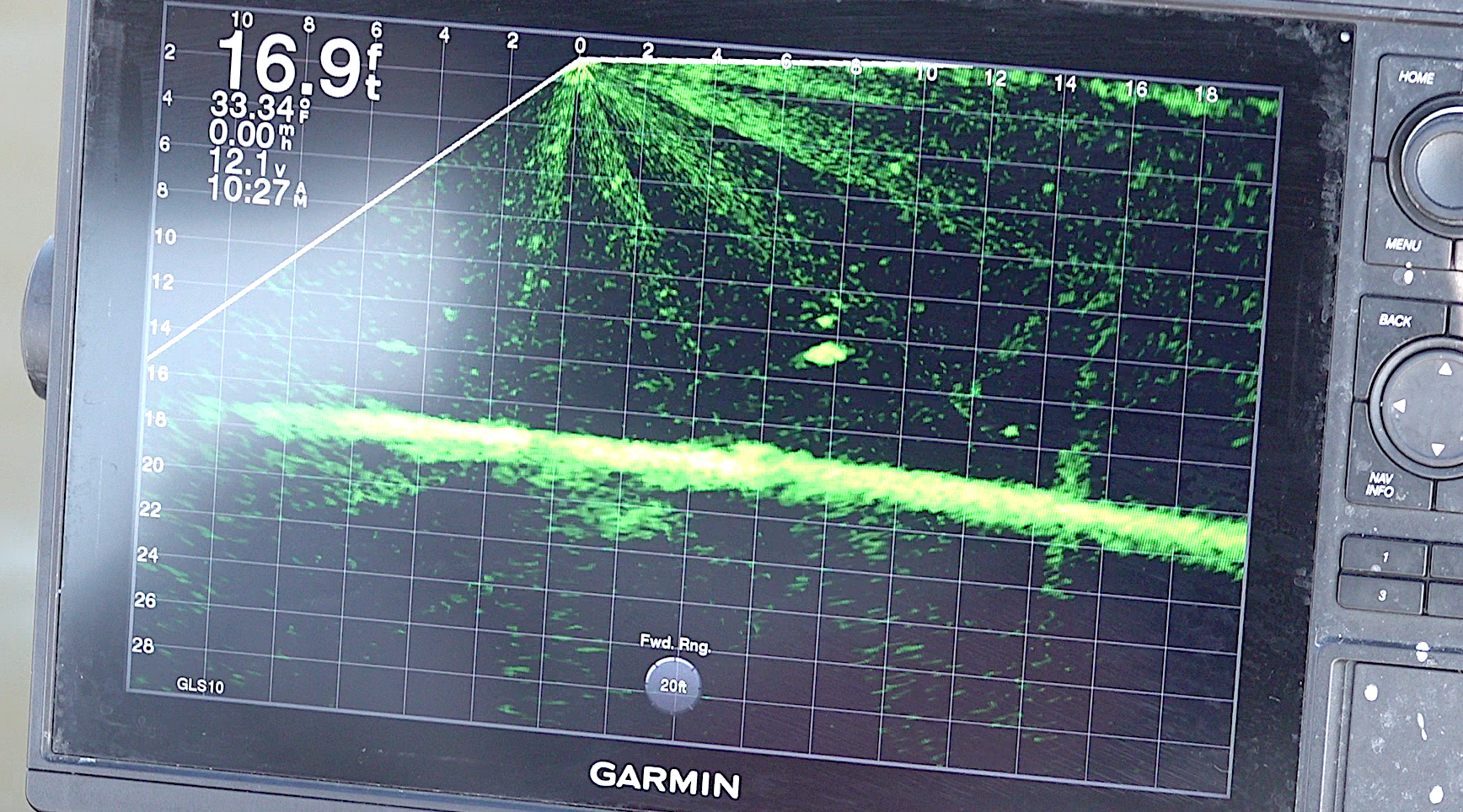

Watching fish movement with live sonar helps McDaniel determine what type of fish he sees on his screen.
“If you ever go to a Bass Pro Shops tank and pay attention to how crappie move you will notice they hardly ever move,” McDaniel said. “They are almost completely stationary and float in place. If you look at other fish like bass, carp and gar, all those other fish in the tank are constantly swimming and moving.
“So, on your live sonar, if you see a fish that is possibly a crappie, watch it for a couple of seconds to see if there is no tail movement and it looks like a football with its tail rounded off. If you hold your live sonar on it for a few seconds and it is not moving at all, or you don’t see any tail movement nine times out of 10 that is a crappie. If you hold your live sonar on it and it almost looks like a torpedo with the top and front rounded, but the end goes into a point with the tail constantly moving, you are going to see flashing on the back side of it. If you see that flashing there then nine times out of 10 it is not a crappie.”
Live sonar also helps McDaniel discern a school of crappie from a pod of baitfish. “A school of crappie is going to almost look like a grapevine of dots, and they are still going to be stationary,” McDaniel said. “Shad on the screen will look like a constant flashing or static because they are constantly flipping. If you watch a ball of shad you are going to see a lot of sparkle on the screen. If the images are dull dots those should be crappie.”
McDaniel can also determine the size of crappie he sees with live sonar. “After you catch enough of them you can really get used to what a big one looks like and what a small one looks like,” he said.
Watching on live sonar how crappie react to his lures helps McDaniel determine the mood of the fish, and the first couple of fish he watches provide a good picture of the fish’s aggressiveness and responses to presentations.
“Sometimes the fish are super aggressive, and sometimes when it is cold, they are super lethargic, and their metabolism has slowed down, so I have to present that bait super slow down to them. You just can’t lob that bait into their face because it will spook them off.”
Live Sonar Presentations
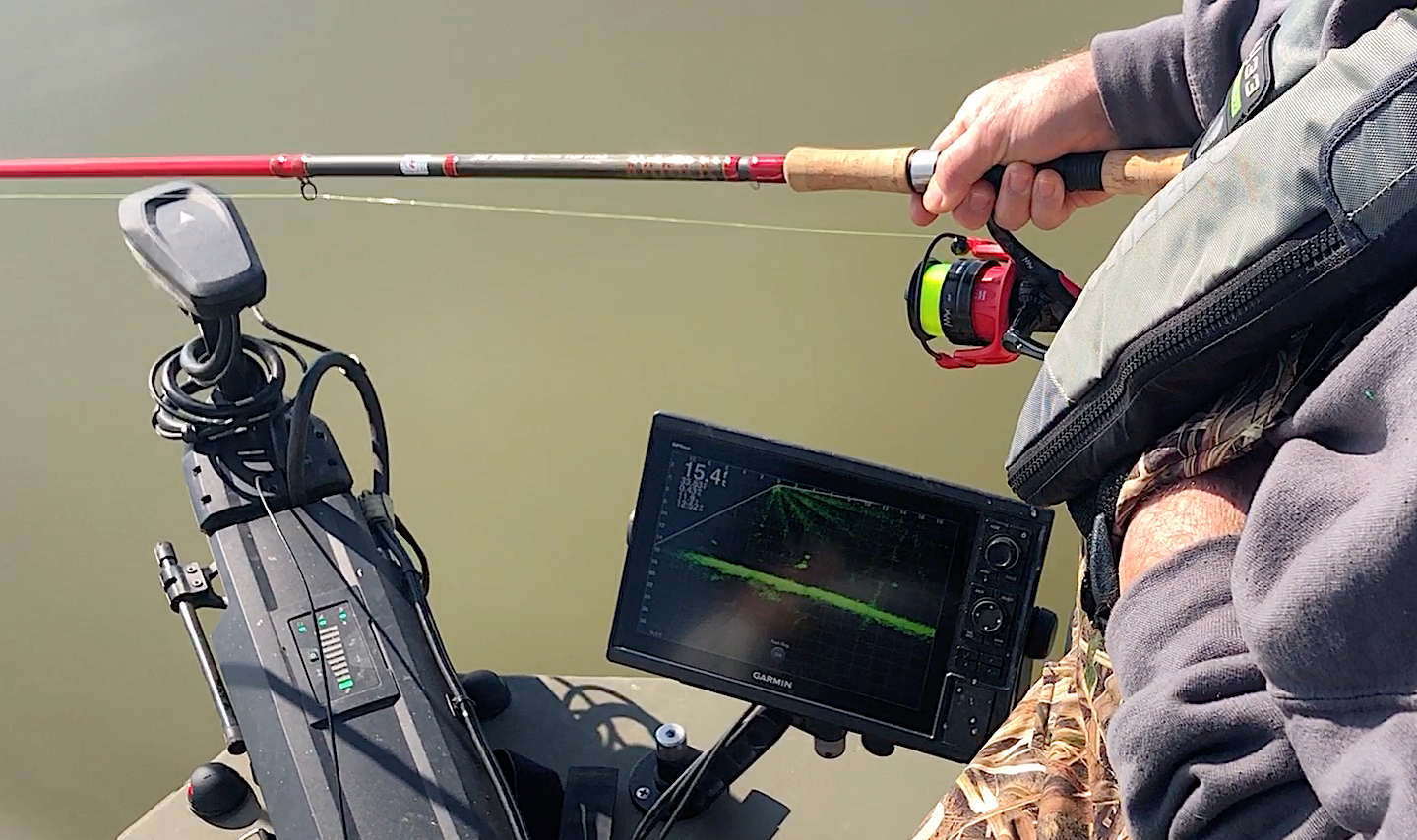

Although live sonar gives anglers confidence they have pinpointed crappie, the fish still must bite. McDaniel’s ability to interpret the mood of the fish allows him to figure out how to present his lures.
Lure presentation becomes most important when he sees crappie swim up and look at his lure but shy away from the bait. “When they do that I slowly raise the bait by slowly reeling it away from them,” he said. “I don’t like to let them look that bait over long enough to figure out it is fake. As soon as they come up to check it out, I bring it away from them so they think it is getting away, and they will usually strike it.”
McDaniel noticed that novice anglers using live sonar tend to stop their lure when a crappie is chasing it. Stopping the lure in front of a crappie looks unnatural and causes the fish to turn away because a baitfish never stops when a crappie is chasing it.
The slow reel presentation produces for McDaniel throughout the year.
“I have had fish 20 to 30 feet deep on a brush pile follow my bait up to within a foot of the surface and hit it right there,” he said. “So, you never want to give up on a slow reel. If they start following it, nine times out of 10 they are caught unless you stop that jig. You want to reel it slow enough to where they can keep following it.”
When his live sonar reveals crappie are in an aggressive mode, McDaniel swims his lure horizontally through the fish. “If you swing the bait across them the first few times and they just maybe turn and look at it or turn and chase it a little bit but quit, you have to go to a vertical presentation because they are not wanting to chase,” he said.
The Oklahoma pro usually makes horizontal presentations in the spring when he can cast his lure 40 feet and watch crappie chase and eat his offering. He relies more on vertical presentations whenever the water is cold, and crappie are lethargic.
Whether he is fishing horizontally or vertically McDaniel relies on his live sonar to keep his lure at the right depth. “It’s crucial never to get the bait under the fish you see on the screen,” he said. “If the bait goes under them nine times out of 10 you have already missed that fish because it spooks the fish when the lure goes past them. Their eyes are on top of their heads, so you always want to keep that jig above them.”
Live sonar also helps McDaniel find and catch big female crappie during the spawn. “When they are spawning, the females will sit out in that 10- to 15-foot range,” he said. “Now you have separated the males and females. The males are up making the beds and all the females are suspended out super shallow in that 14 to 15 feet of water. So, the bigger fish are out there letting their eggs get to the right temperature in that shallower depth over deeper water and at night they roll in and lay their eggs, but then they will come back out to the deeper water.”
Lure Choices
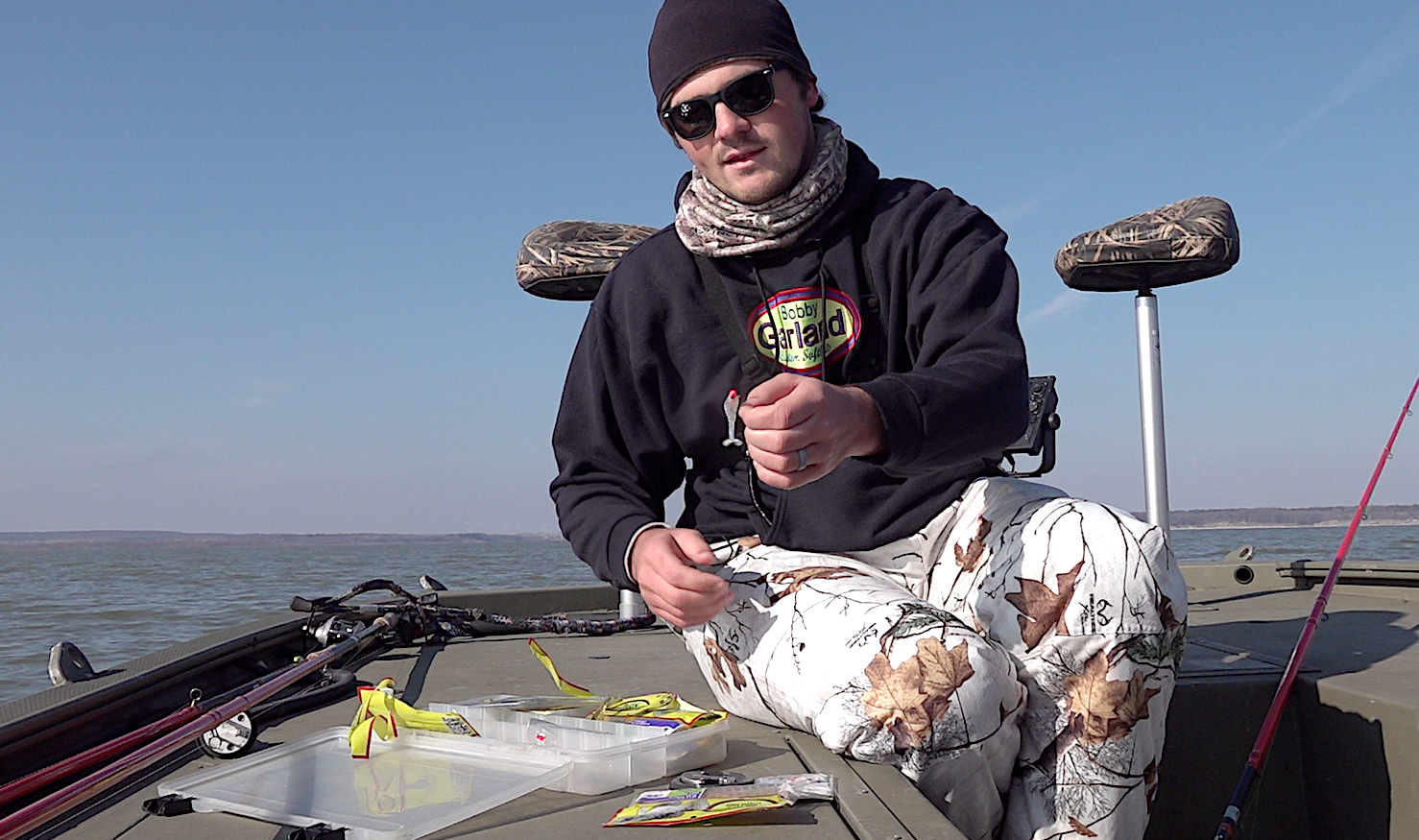

McDaniel fishes a single rod and single jig for his live sonar presentations.
When the water is cold, McDaniel tempts them with a Monkey Milk Bobby Garland Itty Bit Slab Slay’R fished on to a 1/24-ounce Crappie Pro Head DockT’R jighead. He’ll deadstick it for maximized subtlety but enjoy the benefit of the tail action when he starts moving the bait slowly. McDaniel makes his tiny lure more visible on his screen by adding a split-shot weight above the lure.
The Bobby Garland 2.25-inch Slab Hunt’R, also in Monkey Milk, is McDaniel’s favorite lure to throw for aggressive crappie he spots on live sonar. He matches the Slab Hunt’R with a 1/8- or 1/4-ounce jighead, depending on wind or the depth he is fishing.
His favorite lure for most live sonar applications on his home waters of Grand Lake is the blood minnow Baby Shad on a 1/24-ounce jighead.
Setting Up Live Sonar
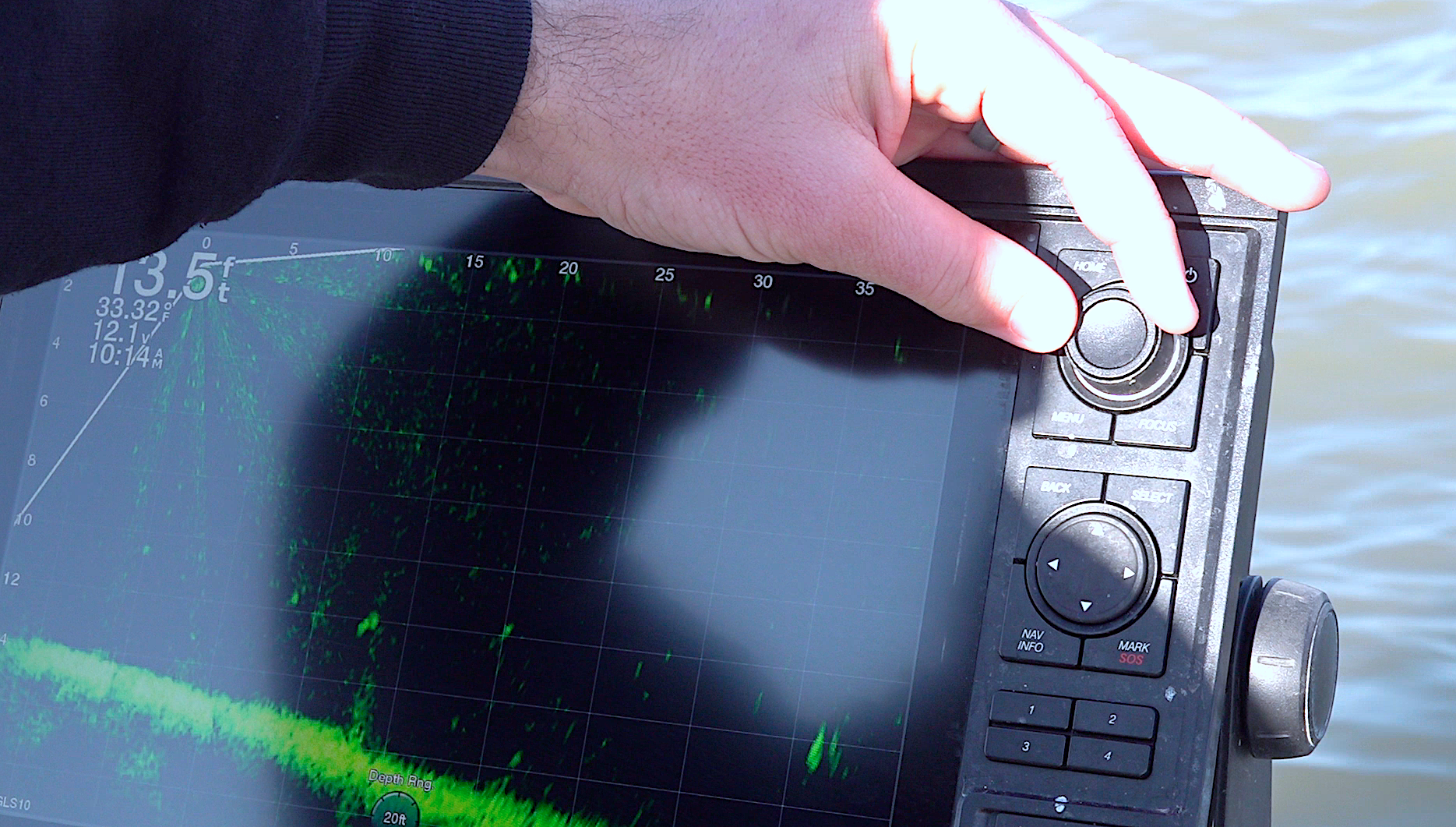

Fine tuning the settings of his live sonar provides Dustin McDaniel with the sharpest screen image for identifying fish and keeping track of his lure.
- McDaniel turns off the unit’s time variable gain (TVG), sets noise reject on low or medium and adjusts the gain (sensitivity) to 65 percent.
- Looking at fish on his unit’s screen helps McDaniel determine if the sensitivity setting is right. When he sees fish, he considers whether the picture is clear or if it is getting too much return or static. If the screen displays too much clutter, McDaniel lowers the sensitivity until the picture becomes clear.
- The forward range for his live sonar is usually set at 40 or 50 feet.
- McDaniel prefers setting his depth range at 40 feet if he is fishing 10 feet or deeper. He changes the depth range to 20 feet when fishing shallower than 10 feet. Moving the depth range up closer to the bottom depth provides a bit more defined picture.
- McDaniel choose the black emerald screen background on his unit for fishing around brush because crappie show up better when they are hanging around brush. The black emerald background is also his choice for viewing on cloudy days. He switches to a copper background for better viewing in bright sunshine.
